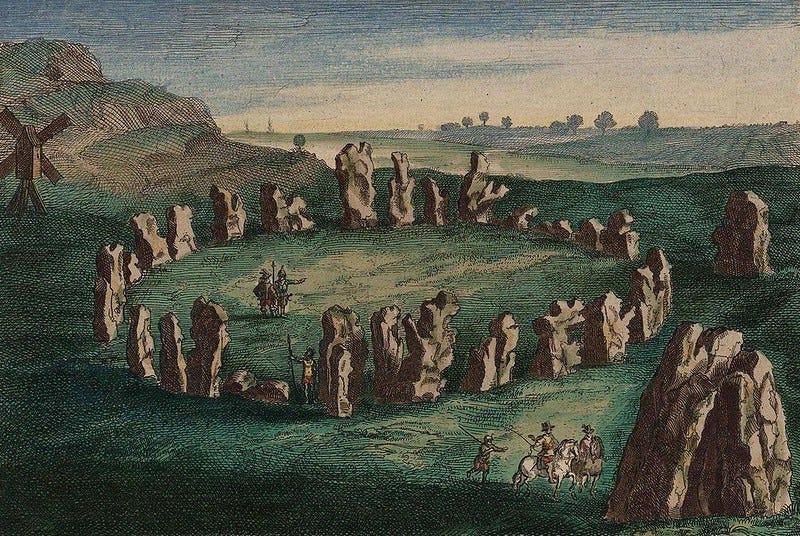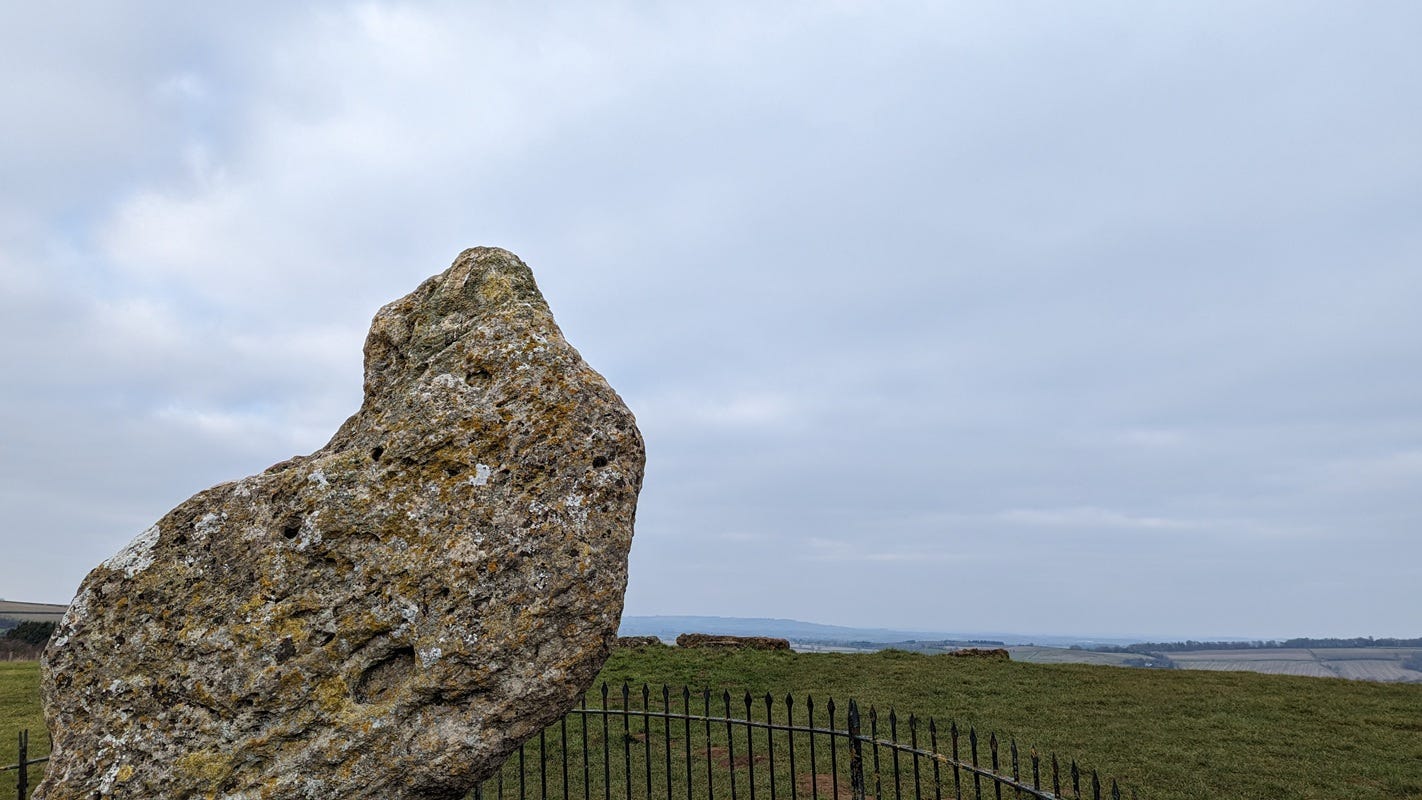Doctor Who's stone circle and the Whispering Knights
High up in the Cotswolds with some very old stones.
I have some exciting writing news for you, but that will have to wait until after I’ve taken you on today’s trip - we’re heading to the Rollright Stones, three ancient monuments in the Cotswolds, straddling the borders of Oxfordshire and Warwickshire.
At first, it might seem as if the three different monuments, each with their own highly poetic name - the King’s Men, the King Stone, and the Whispering Knights - were all built by the same people around the same time. But in fact, the stones were brought here and set up across a period of 2,000 years. It’s incredible that this place, high up on the Cotswolds, could be so significant to human beings for so long. Yet it’s still special now: I’ve visited twice because its magic has got into my bones, and there’s always other people coming to see it. And the stone circle - known as the King’s Men - is sacred to modern pagans.
The Rollright Stones are about a mile south of Long Compton, four miles west of Hook Norton, and about three miles north of Chipping Norton. They’re made from soft, local Cotswold stone, so didn’t travel the vast distances of the boulders that make up Stonehenge. The King’s Stone stands alone on a natural rise in a field which lies at the north of the site. Cross the country lane - which also means leaving south Warwickshire and entering north Oxfordshire - and you enter a small grove of trees. To your right, you’ll see the stone circle, which sits surprisingly close to the road. To your left, further away and more southerly than the circle, are the Whispering Knights.
A legend became attached to the stones, involving a Danish king and a witch. The king encountered the witch at the Rollright Stones, and he asked her if he would become king of England. She told him he’d be king if he walked to the top of the ridge and could see Long Compton below. He did, but discovered his view was blocked by a burial barrow. The witch then turned the king and his men to stone. The king became the King’s Stone, which stands alone near a burial barrow. Four of his knights, who were whispering treacherously behind his back, became the Whispering Knights, and the remainder, who were standing in a circle, became the King’s Men.

The Whispering Knights
The oldest stones are the Whispering Knights, which date from the early Neolithic, around 3,800-3,500 BC. They’ve stood, commanding their view of the surrounding hills, for nearly 5,000 years, marking the spot of a burial. Pottery has been found around it from later periods, so it would’ve been important to people for a long time. And it’s not hard to see why - even though it’s been built from local stone, they’re still enormous slabs which would’ve required enormous effort to move into place. Until the 1700s, the capstone was in place on top of it, making it look even more impressive.
When I’ve stood there next to the stones, thinking about the long-dead human buried there, it seems as if time contracts. As ancient as the monument is, there’s still a connection to be felt between then and now, even though our lives are so different. We still set up memorials for the dead; we still want to remember. Looking up at the stones, we stand where humans have stood for thousands of years, and whether we contemplate infinity, or wonder what we’re having for tea, there is still a link between us.
The King’s Men
The stone circle at Rollright was constructed about 1,000 years after the burial memorialised by The Whispering Knights. The soft stone found in the Cotswolds weathers easily and the seventy-something (the stones are allegedly uncountable) “men” are worn, some with holes going right through. They vary in size - some are quite small, not more than stumps, others are taller than I am, and I don’t know how far they go beneath the soil. Over time, human beings have helped themselves to some of the stones for building work, and they’re not all in their original positions, which explains why the circle is an irregular shape. Despite that, you can still see where the original entrance was, as there’s two stones just outside the circle which mark it.
And now the moment that Whovians have been waiting for: the King’s Men were used in an episode of Doctor Who in 1978, called “The Stones of Blood”, with Tom Baker as the Time Lord. The weathered look of the stones and their irregular poses is very cinematic, much better than a scenery department knocking something together from polystyrene.
The stone circle presumably didn’t mark a burial, but had a devotional purpose. It’s similar to stone circles in the Lake District and eastern Ireland, so it’s thought that the same people built them. The stones are used for devotion even today. The trees which are to the west of the circle are garlanded with pieces of ribbon and cloth, as you see at holy “clootie” wells. I’ve also seen evidence of people leaving offerings and sacrifices there.
It’s the first stone circle I’ve seen since my very first, on a trip to Ireland thirty years ago. I wish I could remember where that was, because I have a vague memory that it was similar to the King’s Men, and I think there was an ancient burial close by as well. The circle is difficult to photograph in a way that captures what it feels like to see it, and I wasn’t quite sure how to interact with the stones, which probably sounds a bit strange, but unlike the other monuments at Rollright, the stone circle isn’t fenced off. You can walk around the circle, walk across it, and even touch the stones. I did all of these things - and only very lightly rested my fingertips on the stones1 - before picturing the ancient people who built the circle, dragging the huge stones here, then after all that effort, quietly engaging with whatever spirits they believed in. They’re not so different to the Mediaeval masons who built the churches and cathedrals that dot the country, using something hard and durable to somehow connect with the invisible.
The King’s Stone
Crossing the lane into Warwickshire, we leave behind the Neolithic and enter the Bronze Age. The King’s Stone is a baby compared to the others, dating from 1,500 BC. It’s surrounded by burials, including a burial cairn that’s now under the grass, and ancient cremations have been found in jars close to the stone, so this part of Rollright is an ancient cemetery. It’s thought the King’s Stone was brought here as a marker.
It’s in a more exposed position than the other two monuments, and is noticeably windier. The view facing north is stunning, and seems like the perfect place to be buried, where it feels as if you’re already halfway into the sky.
The King’s Stone was been fenced off, like The Whispering Knights, in the late 1800s. Its odd shape - it reminded me of a chicken nugget, but that might be because it was getting towards lunchtime - is thanks to souvenir hunters in the 1800s chipping bits off - hence the railings. The same sort of people who carved their initials into other old monuments, like Sir John Knightley’s tomb.
A Knightley knight in Staffordshire
I learnt to drive very late compared to most people. And once we got our car, I wanted to drive out into the countryside and see interesting places. And it just so happened that I could also drive to places connected with my family history which I never thought I’d be able to see.
Visiting the Rollright Stones
So now you’ve read about the Rollright stones, what are the ins-and-outs of actually visiting? First of all, check out the official website.
The site is owned by the Rollright Trust, a private charity, and cared for by English Heritage. There’s no car park, so you have to park in laybys which run along the lane. If it’s busy and the laybys are full, you have to carefully balance the car on the edge of the road, as far away as you can get from the traffic without 1. falling into a ditch, 2. meeting the sheep staring at you in a neighbouring field, or 3. having to climb through a tree. Please be careful and hide your bags etc from view - there are tiny warning posters (fliers, really) courtesy of Thames Valley police on some of the fences near the gate, advising that thieves are about. It’s such a quiet, remote spot, that it’s easy to forget to be careful. Someone’s car was broken into while we were there on our second visit, and sadly, Inspector Morse did not attend (the Rollright Stones would’ve been an amazing location for Endeavour, wouldn’t they!).
You’ll need to pay a small donation, either in a box at the gate, or online (if you can get a signal). There aren’t any staff present. Paths around the site have been set up to make it wheelchair-friendly. There’s no loos or café, which is a bit inconvenient, but a toilet block by 5,000-year-old stones would spoil the atmosphere.
What definitely spoils the atmosphere are the bags of dog-doings which I saw dangling from a fence on the site on my first visit. I loathe the sight of these in parks and woods, but why must they proliferate even here? Eurgh!2 Take your litter home with you. They weren’t there the second time I went, so perhaps I was just unlucky on my first visit!
Something else to be aware of are other kinds of offerings because the stone circle is an active site of pagan worship. It’s partly why a trust was set up to protect them, so that pagans could still access the site, rather than lose it to private owners. As mentioned, the trees are tied with clooties, but I’ve also seen offerings around the stone circle. On my first visit, someone had half-burned a bunch of daffodils in the middle of the circle, and on the second, someone had left a plastic box of chocolate chip cookies on top of one of the stones. Some people have even crammed coins into splits in the stones. I’m all for people enjoying their spiritual beliefs, if they have them, but I do have reservations about people damaging a 4,000-year-old monument in the process, and leaving things around which impinge on the enjoyment of the next person to visit - whether for religious purposes or because they’re a nosey historian. And please don’t leave chocolate around: it’s lethal to dogs, who enjoy coming here too.
That all said, it’s definitely worth a visit, whether you’re a pagan, a Whovian, or just someone (like me) who loves old things! Or, indeed, a dog.
Writing news!
So onto that writing news I mentioned… The Lost Orphans, the first book in the brand new series The Runaway Evacuees, is out on 23rd July and is up for pre-order now on Amazon. It’s written by me and my friend Catherine Curzon, under our joint pen-name, Ellie Curzon. It’ll be available in ebook, paperback, audiobook, and in Kindle Unlimited.
About me
I co-write WW2 saga fiction with my excellent friend Catherine Curzon under our joint pen name, Ellie Curzon.
I’ve written two books on Victorian crime and forensics, and articles for Fortean Times and Family Tree magazine. I’ve appeared on BBC1’s Murder, Mystery and My Family, and BBC Radio 4’s Punt PI. I live in the West Midlands with a cat who looks like a Viking.
You can subscribe to this newsletter for free, or if you love what you’ve read and can find some spare coins down the back of the sofa, you can upgrade to a paid subscription.
And if you just want to chuck a couple of coins my way, you can give me a one-off tip!
And hey - why not share the newsletter with like-minded chums?
I hope I won’t get in trouble for admitting to that! I wasn’t chipping lumps off with a chisel.
Kay Stratton has written about her loathing of this too!












The Whispering Knights are quite magical - something that Penelope Lively captured so well in her children’s novel of the same name.
Well, this is a post right up my street, a wanderer of ancient landscapes. I didn't know about these stones, but now they're on my list of places to visit. Thank you for this 🙏